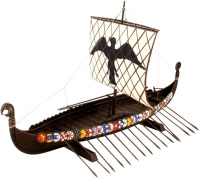Aedes Ars Alexandria Lighthouse Architectural Model Kit - 5500 Pieces AED1271
 | £48.00 Buy! Aedes Ars Alexandria Lighthouse Architectural Model Kit - 5500 Pieces AED1271Hobbies.co.ukDelivery: in United Kingdom Report |
Buy Aedes Ars Alexandria Lighthouse Architectural Model Kit - 5500 Pieces AED1271
When you make a purchase through links on our site, we may receive a affiliate commission.
Aedes Ars Alexandria Lighthouse Architectural Model Kit - 5500 Pieces AED1271 | £47.95 | ||||
Aedes Ars Alexandria Lighthouse Approximate number of pieces: 5500 Difficulty degree: 7.5/10 Sizes: 340 x 340 x 365mm Scale: 1/375 These kits contain high quality ceramic pieces (which simulate the stones and the original materials), cardboard structure guides, glue, scenic material, and guided instructions. Aedes Ars produce a wide range of building sets which are used for the scale reproduction of some historical monuments such as castles, churches, bridges, and lighthouses, (some are recognised World Heritage Sites), as well as diverse miniature buildings of typical country constructions. The monument and its history. The Lighthouse of Alexandria, sometimes called the Pharos of Alexandria, was a lofty tower built by the Ptolemaic Kingdom between 280 and 247 BC and between 393 and 450 ft (120 and 137 m) tall, it was one of the tallest man-made structures on Earth for many centuries, and was regarded as one of the Seven Wonders of the Ancient World. Badly damaged by three earthquakes between 956 and 1323, it then became an abandoned ruin. It was the third longest surviving ancient wonder (after the Mausoleum at Halicarnassus and the still extant Great Pyramid of Giza) until in 1480 the last of its remnant stones were used to build the Citadel of Qaitbay on the site. In 1994, French archaeologists discovered some remains of the lighthouse on the floor of Alexandria's Eastern Harbour.The lighthouse was constructed in the 3rd century BC. After Alexander the Great died of a fever at age 32, the first Ptolemy (Ptolemy I Soter) announced himself king in 305 BC, and commissioned its construction shortly thereafter. The building was finished during the reign of his son, the second Ptolemy (Ptolemy II Philadelphus). It took 12 years to complete, at a total cost of 800 talents, and served as a prototype for all later lighthouses in the world. The light was produced by a furnace at the top and the tower was said to have been built mostly with solid blocks of limestone. Strabo reported that Sostratus had a dedication inscribed in metal letters to the "Saviour Gods". Later Pliny the Elder wrote that Sostratus was the architect, which is disputed. In the second century AD the satirist Lucian wrote that Sostratus inscribed his name under plaster bearing the name of Ptolemy. This was so that when the plaster with Ptolemy's name fell off, Sostratus's name would be visible in the stone.Constructed from large blocks of light-coloured stone, the tower was made up of three stages: a lower square section with a central core, a middle octagonal section, and, at the top, a circular section. At its apex was positioned a mirror which reflected sunlight during the day; a fire was lit at night. Extant Roman coins struck by the Alexandrian mint show that a statue of a Triton was positioned on each of the building's four corners. A statue of Poseidon or Zeus stood atop the lighthouse. The Pharos' masonry blocks were interlocked,
The product description is generated based on data from online stores. Before purchasing be sure to verify all information directly with the seller.

The Most Interesting Generative AI Trends for 2025Exploring how AI will be used in finance, medicine, education, video games, and creativity

Best Portable Laptop StandsFoldable and reliable stands for comfortable laptop use at home, in the office, and on the go
How to place an order?How to add store?
Remember that the online store is responsible for the accuracy of information regarding price, warranty, and delivery!
We recommendCompare using chart →



























